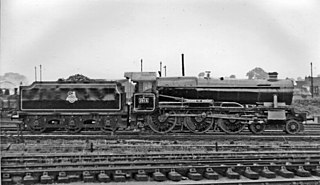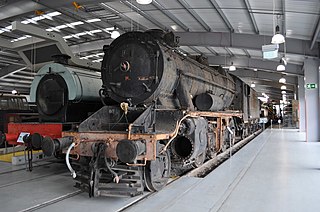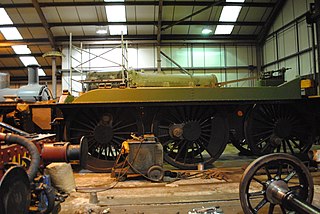The London, Midland and Scottish Railway had the largest stock of steam locomotives of any of the 'Big Four' Grouping, i.e. pre-Nationalisation railway companies in the UK. Despite early troubles arising from factions within the new company, the LMS went on to build some very successful designs; many lasted until the end of steam traction on British Railways in 1968. For an explanation of numbering and classification, see British Rail locomotive and multiple unit numbering and classification.

LNER Class A4 4468 Mallard is a 4-6-2 ("Pacific") steam locomotive built in 1938 for operation on the London and North Eastern Railway (LNER) at Doncaster Works to a design of Nigel Gresley. Its streamlined, wind tunnel tested design allowed it to haul long distance express passenger services at high speeds. On 3 July 1938, Mallard broke the world speed record for steam locomotives at 126 mph (203 km/h), which still stands today.

The steam locomotives of British Railways were used by British Railways over the period 1948–1968. The vast majority of these were inherited from its four constituent companies, the "Big Four".
The London and North Eastern Railway (LNER) produced several classes of locomotive, mostly to the designs of Nigel Gresley, characterised by a three-cylinder layout with a parallel boiler and round-topped firebox. It produced the most famous locomotive of its day, 4468 'Mallard', the holder of the world steam locomotive speed record. It also built the world-famous 4472 'Flying Scotsman'. However, its locomotive inheritance was much greater than just the 'A4 Class', it also produced highly successful mixed-traffic and freight designs.

The British Railways Standard Class 5MT4-6-0 is one of the 12 standard classes of steam locomotive built by British Railways in the 1950s. It was essentially a development of the LMS Stanier Class 5 4-6-0. A total of 172 were built between 1951 and 1957.

The London, Midland and Scottish Railway (LMS) Stanier Class 8F is a class of steam locomotives designed for hauling heavy freight. 852 were built between 1935 and 1946, as a freight version of William Stanier's successful Black Five, and the class saw extensive service overseas during and after the Second World War.

The War Department (WD) "Austerity" 2-8-0 is a type of heavy freight steam locomotive that was introduced in 1943 for war service. A total of 935 were built, making this one of the most-produced classes of British steam locomotive. They were nicknamed Ozzies by the railwaymen.

The Great Central Railway (GCR) Class 8K 2-8-0 is a class of steam locomotive designed for heavy freight. Introduced in 1911, and designed by John G. Robinson, 126 were built for the GCR prior to the First World War. Including wartime construction for the British Army ROD and the post-war GCR Class 8M, the class and its derivatives totalled 666 locomotives.

The London and North Eastern Railway (LNER) Thompson Class B1 is a class of steam locomotive designed by Edward Thompson for medium mixed traffic work.

The Great Western Railway 1000 Class or County Class was a class of 4-6-0 steam locomotive. Thirty examples were built between 1945 and 1947, but all were withdrawn and scrapped in the early 1960s. A replica locomotive is under construction.

Silver Link was the first London and North Eastern Railway (LNER) A4 Class locomotive, built in 1935 to pull a new train called the Silver Jubilee.

The London and North Eastern Railway (LNER) Peppercorn Class A2 is a class of steam locomotive designed for express passenger work by Arthur Peppercorn, the chief designer of the LNER after Edward Thompson. All save the first of the 15 built were constructed under British Railways after nationalisation in 1948. Only one example is preserved.

The London and North Eastern Railway Class U1 was a solitary 2-8-0+0-8-2 Garratt locomotive designed for banking coal trains over the Worsborough Bank, a steeply graded line in South Yorkshire and part of the Woodhead Route. It was both the longest and the most powerful steam locomotive ever to run in Britain. It was built in 1925 with the motion at each end being based on an existing 2-8-0 design. The original number was 2395, and it was renumbered 9999 in March 1946, and then 69999 after nationalisation in 1948, although it retained its cab-side plate bearing its original number throughout its life. The locomotive ran for some time as an oil burner, and was tried out on the Lickey Incline in 1949–1950 and again, after the electrification of its home line, in 1955. These trials were unsuccessful, and so the locomotive was withdrawn in 1955 and scrapped.

LMS Stanier Class 8F No. 8233, War Department Nos. 307, and later 70307, Iranian State Railways No. 41-109, Longmoor Military Railway 500, British Railways No. 48773, is a preserved British steam locomotive. Its owners claim that it is "possibly Britain's most travelled preserved locomotive".

The TCDD 45151 Class is a class of 2-8-0 steam locomotives which were acquired from the British War Department to the LMS Stanier Class 8F design. They had a maximum speed of 43 miles per hour (70 km/h), much like their British counterparts.

The LNER W1 No. 10000 was an experimental steam locomotive fitted with a high pressure water-tube boiler. Nigel Gresley was impressed by the results of using high-pressure steam in marine applications and so in 1924 he approached Harold Yarrow of shipyard and boilermakers Yarrow & Company of Glasgow to design a suitable boiler for a railway locomotive, based on Yarrow's design.

London and North Eastern Railway (LNER) Thompson Class B1 No. 1264, is a preserved British steam locomotive.

The British Railways (BR) ex-WD Austerity 2-8-0 was a class of 733 2-8-0 steam locomotives designed for heavy freight. These locomotives of the WD Austerity 2-8-0 type had been constructed by the War Department, as war locomotives 1943–1945. After the war, they were surplus and so in 1946 the LNER bought 200 of them, classifying them as LNER Class O7, and by the end of 1947 when the LNER was nationalised, had taken another 278 O7s on loan. After nationalisation, BR purchased 533 more 2-8-0s, including all of those on loan, giving a class total of 733. As many of these needed overhauling before being put to work, they were activated slowly. BR chose to reclassified from LNER Class O7 and renumbered them from the 6xxxx LNER series in the 90000–732 series for BR standard designs.

No.1014 County of Glamorgan is a steam locomotive which is under construction as a "new-build" project, based at Didcot Railway Centre in Didcot, Oxfordshire. Unlike most other new-build projects which are underway and are building new members of lost classes like 2007 Prince of Wales and 2999 Lady of Legend it was decided to build a mock of one of the Great Western Railway 1000 or "County" Class engines, the chosen engine being 1014 The project was launched in 2005 with the creation of the 'Three Counties Agreement' between the Great Western Society (GWS) and the Vale of Glamorgan Council saw three members of the Barry 10, all of the being ex-GWR locomotives, and a 3,500-gallon tender being used to help resurrect extinct GWR locomotives. This meant that a GWR 1000 Class No. 1014 County of Glamorgan, GWR 3800 Class No. 3840 County of Montgomery, a GWR 2221 Class tank engine, and a GWR 4700 Class No. 4709 would be constructed from the parts of GWR 2800 Class No. 2861, GWR 5101 Class No. 4115, GWR 5205 Class No. 5227, GWR 6959 Class No. 7927 Willington Hall and LMS 8F No. 48518.
















